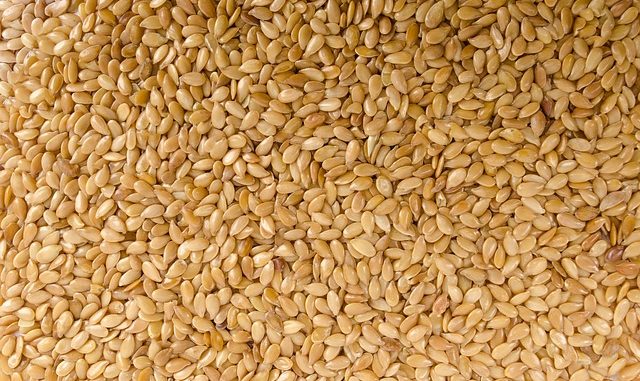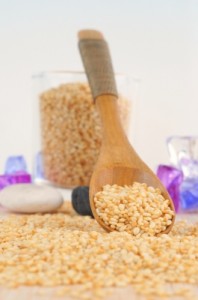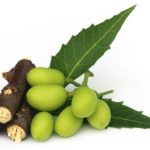
Sesame seeds (Sesamum indicum L., Pedaliaceae) are a constant hazard for those with an allergy to them but they do yield an extremely valuable culinary oil (Lyon, 1971). In fact thy can even stabilise more susceptible oils such as soya oil. Sesame is cultivated throughout Asia and African and more recently in South America. Here we look at some important components in sesame seed oil.

Sesame Seed Oil
Sesame seed oil has a slightly nutty flavour and makes an excellent addition to salads, or to stir fries when toasted. It requires little winterizing – that means there is hardly any need to remove the higher melting point fats such as the waxes which can reduce palatability and storage.
Sesame seed oil contains unusual compounds such as sesamol, sesamolin and sesamin. These are polyphenols and lignans which have proven to be powerful natural antioxidants. These are all compounds too which are peculiar to this seed oil and make it a characteristic oil which reduces its use as an adulterating agent.
Sesamol is the main component of the oil – especially evident in the roasted form and is responsible for the very high antioxidant content. The seeds themselves have little of this component but have sesamin and sesamolin instead which are lignans. Sesamol is generated during heating, especially roasting and storage of the oil, from sesamolin following acidic extraction (Namiki, 1995). The most effective heating processes can use both oven, infra-red (Kumar et al., 2009) or microwaving.
Industrial processors also add extra sesamol to improve the stabilizing benefits of the oil (Kikugawa et al., 1983; Fukuda et al., 1986) and being thermally stable will retain this activity throughout the oil’s shelf-life. Another excellent property of sesamol is its water solubility and partitions in both oil and aqueous phases. The chemical structure is a benzodioxole ring which acts as the free radical scavenger, mainly of hydroxyl radicals. The chemical 1,2-dihydroxybenzene is produced.
Sesamol can be used in combination with other antioxidants to cover a greater range of radicals. Tocopherol, tocopherol and gallate have all been successfully applied with sesamol in reducing the loss of volatiles and other flavour compounds during irradiation of meat such as turkey pieces (Lee & Ahn, 2003).
If it has these properties with meat, it might help with anti-ageing and there is certainly some evidence for this from lab studies as there is for its antimutagenic properties (Kapadia et al., 2002; Geetha et al., 2009). With in vitro tests, it is known to be active against a wide variety of reactive species and might work with ascorbic acid (vitamin C) in this regard. The lignans and their glycoside derivatives apparently have hypocholesterolemic benefits ( Ide et al., 2001).
What Is So Special Then About Sesamin ?
Sesamin is the most abundant lignan in sesame seeds and the oil. It has a well established neuroprotective benefit. At the molecule level it is now thought to modulate microglia activation and reduce neuroinflammation. That implies it could even prevent neurodegeneration by a number of diseases. The mechanism by which it achieves this is to influence the behaviour of certain receptors which control the production of inflammation factors. It also protects some neurones from certain death (Udomruk et al., 2018).
References
Fukuda, Y., Nagata, M., Osawa, T., Namiki, M. (1986) Chemical aspects of the antioxidative activity of roasted sesame seed oil and the effect of using the oil for frying. Agric. Biol. Chem. 50 pp. 857–62 (Article).
Geetha, T., Rohit, B., Pal, Kl. (2009) Sesamol: an efficient antioxidant with potential therapeutic benefits. Med. Chem. 5(4) pp. 367-371
Ide, T., Ashakumary, L., Takahashi, Y. et al. (2001). Sesamin, a sesame lignan, decreases fatty acid synthesis in rat liver accompanying the down-regulation of sterol regulatory element binding protein-1. Biochim. Biophys. Acta, 1534, pp. 1–13.
Kapadia, G.J., Azuine, M.A., Tokuda, H. et al. (2002). Chemopreventive effect of resveratrol, sesamol, sesame oil and sunflower oil in the Epstein–Barr virus early antigen activation assay and the mouse skin two-stage carcinogenesis. Pharma. Res. Commun.45 pp. 499–505.
Kikugawa, K., Arai, M., Kurechi, T. (1983) Participation of sesamol in stability of sesame oil. J. Am. Oil Chem. Soc. 60 pp. 1528–33.
Kumar, C. M., Appu Rao, A.G. and Singh, S. A. (2009), Effect of Infrared Heating on the Formation of Sesamol and Quality of Defatted Flours from Sesamum indicum L. J. Food Sci., 74: H105–H111. doi: 10.1111/j.1750-3841.2009.01132.x
Lee, E.J., Ahn, D.U. (2003) Effect of Antioxidants on the Production of Off-Odor Volatiles and Lipid Oxidation in Irradiated Turkey Breast Meat and Meat Homogenates. J. Food Sci., 68(5) pp 1631-1638
Lyon, C.K. (1971) Sesame: current knowledge of composition and use. J. Am. Oil Chem. Soc. 49 pp. 245–8.
Namiki, M. (1995) The chemistry and physiological functions of sesame. Food Rev. Int. 11 pp. 281–329.
Udomruk, S., Kaewmool, C., Pothacharoen, P., Phitak, T., Kongtawelert, P. (2018) Sesamin suppresses LPS-induced microglial activation via regulation of TLR4 expression. J. Func. Foods 49 October pp. 32-43



Leave a Reply